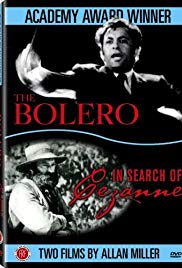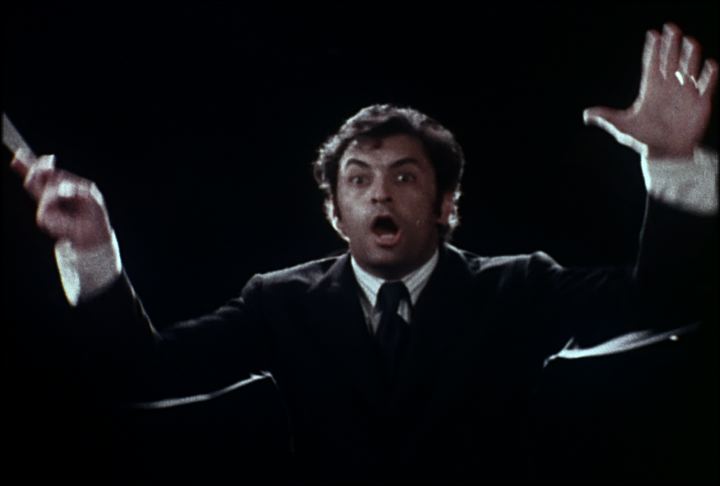THE BOLERO
SUBJECTS — Music (Classical);
SOCIAL-EMOTIONAL LEARNING — Talent;
MORAL-ETHICAL EMPHASIS — None.
AGE: 9+
MPAA Rating — Not Rated; Short subject documentary; 1973; 26 minutes; Color.
There is NO AI content on this website. All content on TeachWithMovies.org has been written by human beings.

SUBJECTS — Music (Classical);
SOCIAL-EMOTIONAL LEARNING — Talent;
MORAL-ETHICAL EMPHASIS — None.
AGE: 9+
MPAA Rating — Not Rated; Short subject documentary; 1973; 26 minutes; Color.
This is an Academy award-winning presentation of the Los Angeles Philharmonic performing Maurice Ravel’s symphonic masterpiece. Zubin Mehta, the conductor, and several members of the orchestra provide commentary on the music and their work as musicians. The instruments featured include: flute, clarinet, bassoon, E-flat clarinet, oboe d’amore, trumpet, tenor saxophone, soprano saxophone, piccolo, trombone and violin. The music is excellent and the camera work extraordinary.
Selected Awards: 1974 Academy Awards: Best Short Subject, Live Action Film.
Featured Actors: Zubin Mehta, as himself.
Director: William Fertik.
“The Bolero” lasts only 26 minutes, but it can be of great assistance in introducing classical music to secondary school students. The film also provides an introduction to many instruments of the modern orchestra. The comments by Mr. Mehta and some of the musicians personalize the music and give students a little information about the lives of classical musicians.
NONE.
Watch the film with your child. If at all possible attend a performance of Bolero. It is much more exciting when performed live.
Ravel: Joseph-Maurice Ravel (1875 – 1937) was a French composer and pianist known especially for the subtlety, richness, and poignancy of his melodies. Ravel’s compositions are also characterized by rich orchestral and instrumental textures. Ravel’s music is a staple of the modern repertoire for orchestra, piano, chamber music, and voice.
The Composition: Boléro is Ravel’s most popular orchestral work, but it was originally composed as a ballet score and is still used as the music for many dances. The trick of interpreting the piece, as stated by Zubin Mehta in the film, is to control the build-up of tension.
When Ravel came up with the theme for Boléro, he reportedly played it for a friend and said, “Don’t you think this theme has an insistent quality? I’m going to try and repeat it a number of times without any development, gradually increasing the orchestra as best I can.” Ravel by Arbie Orenstein, 1991 p. 98
Boléro consists of 18 cycles of the same melody. In each cycle, instruments are added, the orchestration is varied, and the orchestra plays with increased energy, growing more insistent and louder. While the melody repeats itself, “the colors and contest are always changing.” In the final cycle, the orchestra roars with overpowering rhythm and power. Quoted language is taken from Phil plays it safe but plays it well, by Mark Swed, Los Angeles Times Music Critic, Reviewing the October 4, 2008 performance of Boléro by the Los Angeles Philharmonic Orchestra, L.A. Times October 6, 2008, page E3.
Symphony Orchestras: The modern orchestra that plays classical European music usually has four sections: stringed instruments played with a bow, woodwinds, brass, and percussion. Modern orchestras are led by a conductor who interprets the music, establishing the mood of the piece, setting the tone and the phrasing. It is the conductor who keeps time for the orchestra, decides upon the speed of the music, and determines the volume of each group of instruments. The conductor also leads the orchestra in both rehearsal and concert.
A full-scale symphony orchestra has more than 100 members, approximately half playing stringed instruments. A chamber orchestra has less than 50 members. Orchestras typically have a seating arrangement with the violins to the conductor’s left through the center, then the violas and other stringed instruments on the right. Arrayed in back of them are the woodwinds and brass. The percussion instruments are usually in the last row.
The word “orchestra” is derived from the Greek “orche-stra” which refers to the circular section of the ancient Greek theatre in front of the proscenium where the dancers and instrumentalists performed.
Beginning in the 1600s, the size and complexity of orchestras grew as composers and orchestra leaders added instruments to increase the variety of the sound, to give the music more depth, and to increase volume. The 19th century was a very fertile period for the development of orchestral music.
The Conductor: Zubin Mehta was born in Bombay, India in 1936. He was introduced to classical Western music by his father, who was the founder of the Bombay Symphony Orchestra. Mr. Mehta has had long tenures as the conductor or musical director for the following orchestras: Montreal Symphony Orchestra (1961 to 1967); Los Angeles Philharmonic Orchestra (1962 – 1978); Israel Philharmonic Orchestra (1969 – current); New York Philharmonic (1978 – 1991); and the Teatro del Maggio Musicale Fiorentino in Florence, Italy (1985 – present). Mr. Mehta has received numerous awards for his musicianship and artistry.

Thirty-five years after this movie was filmed, the Los Angeles Philharmonic is still performing Boléro. On October 4 and 5, 2008 the author of this Learning Guide attended two, back-to-back performances of Boléro at the Walt Disney Concert Hall in Los Angeles. The conductor was Esa-Pekka Salonen.
While both performances were fabulous and each received a standing ovation, they were different in interesting ways. On Saturday night, October 4, the drum that starts the piece began with a relatively fast tempo. One wondered how the orchestra would be able to increase the tempo through to the end. The orchestra itself seemed full of energy. Mr. Salonen’s style of conducting this performance was understated; his main effort was to hold the orchestra back. In the last repetition of the melody, the grand finale, Mr. Salonen hardly directed at all and let the orchestra go all out on its own. The next day, for the Sunday matinee, the orchestra itself seemed to have less energy. Perhaps the musicians were tired after playing the night before. Perhaps it was because a different drummer had started the piece at a slower tempo. In the matinee, Mr. Salonen’s style of conducting was very animated, with large sweeps of his arms injecting energy into the orchestra. The effect was the same; the music was electrifying. However, the same conductor approached the piece very differently from one performance to the other.
This is an excellent short subject to show to a music or orchestra class. After the movie, go through Discussion Questions 2 – 5. Follow it up with the listening and writing assignment.
1. See Questions Suitable for Any Film.
2. What is the structure of Ravel’s Boléro?
Suggested Response:
One musical phrase is repeated 18 times with different instruments and orchestration. At first, the energy level is restrained, the tempo is medium, and the volume is soft. The first bars of the piece are played only by the flute. As the piece progresses, additional instruments join in and the energy level mounts; the passion, tempo and volume increase to a grand finale.
3. What must a conductor always be aware of when leading an orchestra in Ravel’s Boléro?
Suggested Response:
He must keep the tension building or, in other words, he must control the build-up of passion, tempo, and volume so that each of these can increase all the way to the finale. This means holding back throughout most of the piece.
4. What is the role of the conductor in an orchestra?
Suggested Response:
The conductor interprets the music, establishing the mood of the piece, setting the tone and phrasing. The conductor determines the speed of the music and the volume of each group of instruments. The conductor also leads the orchestra as it practices and when it plays in concert.
5. Why would composers and leaders of orchestras add new instruments?
Suggested Response:
Composers and leaders of orchestras added instruments to increase the variety of sound, to give the music more depth, and to increase volume.
6. What are the four major sections of a modern orchestra?
Suggested Response:
Strings, woodwinds, brass and percussion.
1. One member of the orchestra says that being a musician requires a little talent and a lot of work. Do you agree or disagree?
Suggested Response:
A strong answer will agree, although there are a few people in the world whose natural genius sets them above everyone, even talented people who work hard. Note that the situation in which a talented hard working musician sees himself easily eclipsed by a ne’er-do-well genius is fully developed in the film version of the play “Amadeus“.
1. Boléro takes from 13 – 15 minutes to perform. Have the class listen or watch one version in addition to the performance contained in the film and then write a paragraph or an essay comparing and contrasting the two performances. There are several performances of Boléro available free on the Internet. Students should listen to the second performance with paper and pen in hand, ready to take notes.
My Bionic Question by Michael Chorost, Wired Magazine November 2005;
Wikipedia Article on Boléro; This is a complete and well-researched article;
Biography of Zubin Mehta from his own official website.
The article entitled orchestra in the online Encyclopædia Britannica. Retrieved September 28, 2008.
This Learning Guide was last updated on December 9, 2009.